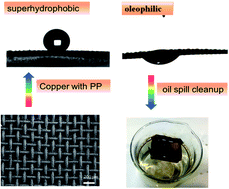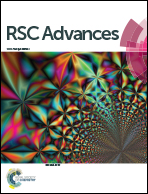Superhydrophobic engineering materials provide a rapid and simple route for highly efficient self-driven crude oil spill cleanup†
Abstract
Traditional superhydrophobic material use depends on two processes: creating a rough structure on a material surface and modifying the rough surface with low surface energy materials. However, common preparation methods are time-consuming, complex and cost-ineffective. Furthermore, these methods usually rely on chemicals, and evidently that will restrict mass preparation and application of superhydrophobic materials. This study reports a simple polypropylene (PP) solution-based process for producing PP hierarchical structures on commercial copper mesh (low surface energy materials), without modifying the low surface energy materials. The hierarchical structures of copper meshes, surface modified with PP, can be rationally controlled by optimizing the PP concentration. The obtained copper mesh showed contact and rolling off angles of 162° and 7°, respectively. Importantly, no significant performance loss was observed after the superhydrophobic copper meshes were continuously and drastically rinsed with 3.5 wt% NaCl solution, or repeated tearing with an adhesive tape for more than 30 cycles, indicating its good durability. After surface modification with PP particles, the copper mesh exhibits both excellent superhydrophobicity and superoleophilicity. Additionally, the as-prepared copper mesh can self-float on water surface when deformed into a “miniature boat” shape. Meanwhile, self-driven spilled oil cleanup was achieved using a superhydrophobic copper mesh-formed miniature boat. The miniature boat can realize energy conservation as well as high efficiency. The cleanup rate of the boat is as high as 97.1%, demonstrating its great potential in environmental remediation applications.



 Please wait while we load your content...
Please wait while we load your content...